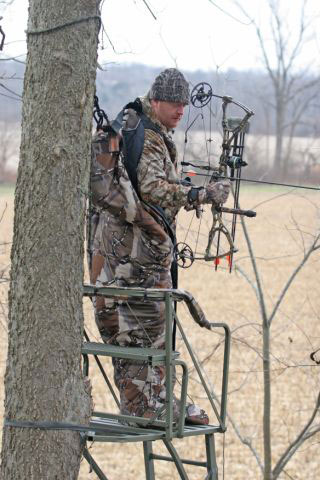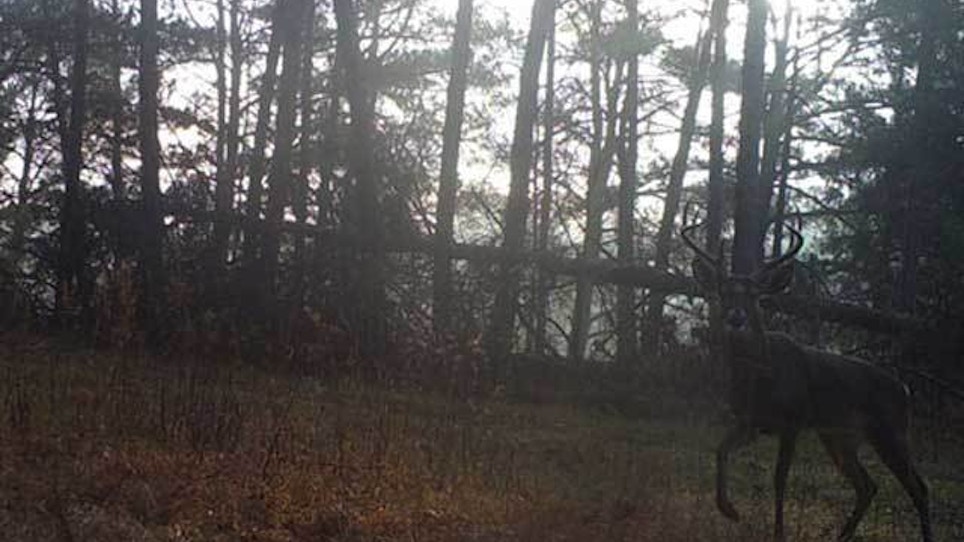Deer are mysterious creatures, and predicting their movements can be a daunting task. They generally appear with regularity during the months of August and September and briefly in October, only to vanish and reappear in late October.
Steven Stewart used to oversee a ranch near Ada, Okla. For two months he had been watching an awesome buck feed like clockwork in a big wheat field — always in the early morning and at last light. Stewart's game cameras chronicled the growth of this giant buck from velvet to hard antler. Two weeks before I hunted there, the big typical buck vanished. In an effort to find the buck, Stewart checked all 15 of his Moultrie game cameras every three days, but to no avail. The giant buck was nowhere to be found.
The day before Oklahoma's blackpowder season opened, I called Steven for directions to the ranch, and the young deer guide enthusiastically told me he had some good news for me. "I have something that I want to show you when you get here," he said. That news piqued my interest, and I hotfooted it to the lodge at warp speed.
Stewart showed me recent images of the huge buck — he had returned and was working on a rub very close to where my treestand was placed. "You will be in that stand in the morning, and you should see that big buck," he reasoned.
In the next two days the huge buck never appeared, but game camera photos revealed the giant fed at a nearby corn feeder an hour before and an hour after dark. I was perplexed, but I realized this 4 ½-year-old buck didn't get old and grow big headgear by being careless.
 Deer Movements During The Early Season
Deer Movements During The Early Season
When whitetail bucks come out of velvet, there is a marked increase in testosterone production. While bucks are in velvet, they generally hang out in bachelor groups and start establishing a pecking order. After bucks rub off their velvet, they become territorial and normally travel alone.
Though bucks and does can be seen feeding together in fields, generally speaking, bucks live solitary lives until they seek out receptive does for breeding.
During the pre-rut, whitetail bucks will mark the territory with scent posts and scrapes. Scrapes are excellent areas to place a game camera nearby. You can bet the bucks will come back by to visit these spots — more frequently as the rut approaches.
Though whitetail bucks spar year-round mostly in a playful posture, just prior to the rut, their playful jousting becomes very aggressive. Sometimes bucks are injured during this sparring and later die, while others may lose eyes or have hideous sores that will fester with infection. This display of dominance will determine which bucks are able to breed most of the receptive does in their core areas.
Generally, whitetail bucks will make rub lines, which consist of a series of saplings along a trail that bucks rub their antlers on. When bucks come out of velvet they rub trees to remove the bothersome velvet from their antlers, but during the rut these trees and saplings become marked, signifying the area belongs to a particular buck. These antler rubs can be made on small trees, but usually bigger bucks prefer larger trees. The rubbing removes bark and exposes the bare wood. These saplings can be spaced out as far as 20 yards apart, though on one occasion I saw a rub line with saplings rubbed every 10 feet. Normally, along these rub lines, bucks will find a suitable overhanging branch and make a scrape beneath it. The overhanging branch is either used as a licking branch or as a place for a buck to rub his pre-orbital gland. Near a rub line is also an excellent area to place a game camera.
A scrape is a pawed-out area of earth that can be as small as a foot in diameter, to as large as 3 or 4 feet. Whitetails paw the earth and eventually remove all the leaves and grass from the area, while leaving scent from their interdigital glands located between their hooves. Bucks visit these sights daily and urinate in their scrapes to freshen them, while checking to see if any does have urinated in them, as well. When urinating, both bucks and does press their rear hocks together and urinate across their metatarsal glands, which deposit an added scent. Most bucks will have multiple scrapes in their core areas, and they will spend much of their day checking these scrapes for a receptive doe that may have left her urinated "calling card." An active scrape is another excellent spot to hang a camera nearby.
Bucks will also chase does looking for receptive does to breed, however, until a doe comes into estrus, she will run and play hard to get. Bucks will also display a lip curl or flehmen pose, while they sniff does for a pheromone that indicates a doe is in estrus. A gland in the upper palate of a buck's mouth called a vomeronasal organ deciphers whether the doe's urine is indicating she is in "heat" and receptive to be bred.
Simply put: Any areas where does frequent are good spots to place game cameras. Keep in mind that you should always take scent-control precautions before setting out any game cameras. Any areas where you leave an abundance of human scent can cause the deer to become nocturnal or worse yet, leave the area.






